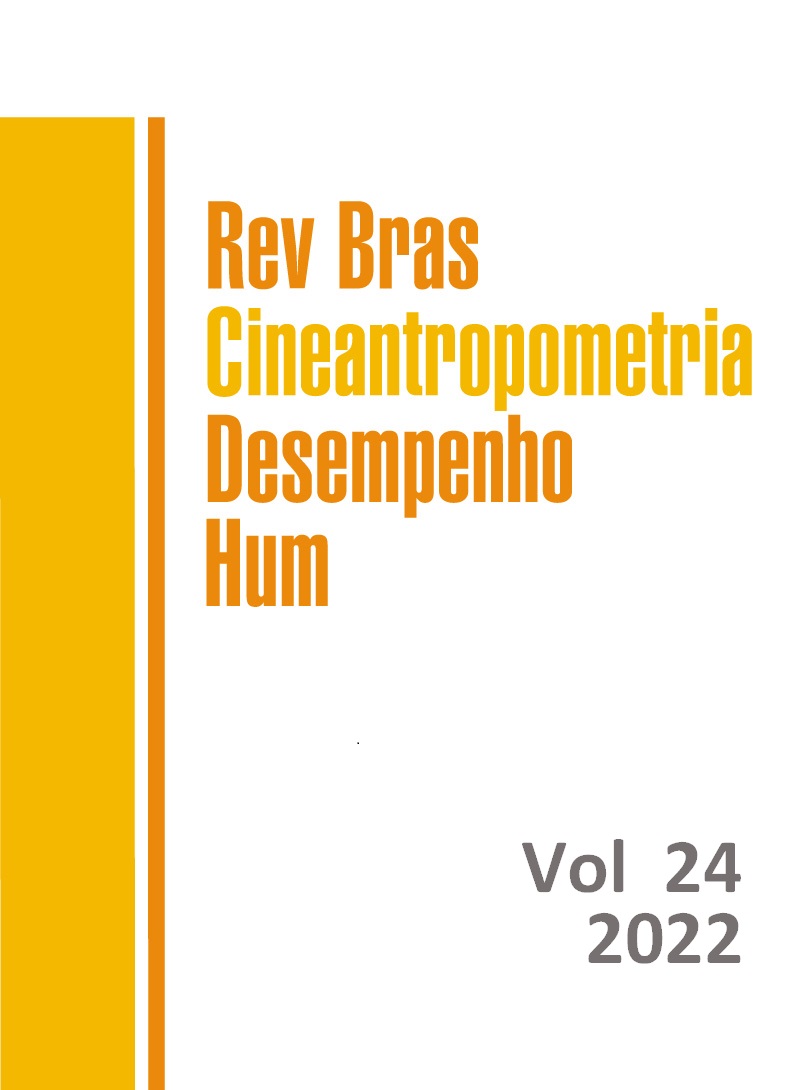Flexibility of Brazilian children and adolescents: a systematic review of the literature
DOI:
https://doi.org/10.1590/1980-0037.2022v24e87232Keywords:
Adolescent, Child, Flexibility, Physical fitnessAbstract
Flexibility is related to specific tissue properties of the body, which aim to determine the maximum range of motion of the joints without injury. This study aimed to identify and summarize the evidence on prevalence of adequate levels of flexibility in Brazilian children and adolescents (6 to 19 years old). We performed a systematic search of studies published from 2009 to 2019 in six databases (MEDLINE/PubMed; Scopus; SportDiscus; LILACS; Web of Science; SCIELO). Fourteen studies that compiled data from 11,666 participants in seven different Brazilian states were included. All studies conducted sit and reach tests to assess flexibility. Among all the children and adolescents in the analyzed studies, 58.9% of the total (62.0% of boys and 50.9% of girls) had adequate flexibility. We conclude that more than half of Brazilian children and adolescents have adequate flexibility for health.
References
Nuzzo JL. The Case for Retiring Flexibility as a Major Component of Physical Fitness. Sports Med. 2020;50(5):853–70.
American College Of Sports Medicine. ACSM’s guidelines for exercise testing and prescription. 10th ed. Philadelphia: Wolters Kluwer; 2018.
Plowman SA. Top 10 Research Questions Related to Musculoskeletal Physical Fitness Testing in Children and Adolescents. Res Q Exerc Sport. 2014;85(2):174–87.
Kohl HW, Cook HD. Educating the Student Body: Taking Physical Activity and Physical Education to School. Educating the Student Body. Washington (DC): National Academies Press (US); 2013.
Batista KR de O, Couto JDO, Oliveira MGD de, Silva RJ dos S. Flexibilidade em crianças e adolescentes brasileiros: uma revisão sistemática. Rev Bras Cineantropom Desempenho Hum. 2018;20(4):472–82.
Arruda GA de, Oliveira AR de. Concordância entre os critérios para flexibilidade de crianças e adolescentes estabelecidos pela physical best e fitnessgram. Rev Educ Fis/UEM. 2012; 23(2):183–94.
Minatto G, Ribeiro RR, Achour Junior A, Santos KD. Idade, maturação sexual, variáveis antropométricas e composição corporal: influências na flexibilidade. Rev Bras Cineantropom Desempenho Hum. 2010;12(3):151–8.
Minatto G, Petroski EL, Silva DAS. Health-related physical fitness in Brazilian adolescents from a small town of German colonization. Rev Andal Med Deporte. 2016;9(2):67–74.
Pereira TA, Bergmann ML de A, Bergmann GG. Fatores associados à baixa aptidão física de adolescentes. Rev Bras Med Esporte. 2016;22(3):176–81.
Pires-Júnior R, Coledam DHC, Greca JP de A, Arruda GA de, Teixeira M, Oliveira AR de. Physical fitness and health-related quality of life in Brazilian adolescents: a cross-sectional study. Hum Mov 2018;2018(2):3–10.
Schubert A, Januário RSB, Casonatto J, Sonoo CN. Aptidão física relacionada à prática esportiva em crianças e adolescentes. Rev Bras Med Esporte. 2016;22(2):142–6.
Andreasi V, Michelin E, Rinaldi AEM, Burini RC. Physical fitness and associations with anthropometric measurements in 7 to 15-year-old school children. J Pediatr. 2010;0(0):497–502.
Guedes DP, Miranda Neto J, Lopes VP, Silva AJ. Health-related physical fitness is associated with selected sociodemographic and behavioral factors in Brazilian school children. J Phys Act Health. 2012;9(4):473–80.
Martins-Costa HC, Araújo SRS, Lima FV, Menzel HJ, Fernandes AP, Chagas MH. Análise do perfil da flexibilidade de crianças e adolescentes mensurada por meio de dois testes. J Phys Educ. 2015;26(2):257–65.
Petroski EL, Silva AF da, Rodrigues AB, Pelegrini A. Aptidão física relacionada a saúde em adolescentes brasileiros residentes em áreas de médio/baixo índice de desenvolvimento humano. Rev Salud Pública. 2011;13(2):219–28.
Castro FJS de, Cabral de Oliveira AC. Associação entre a aptidão física relacionada à saúde e o desempenho acadêmico em adolescentes. Rev Bras Cineantropom Desempenho Hum. 2016;18(4):441.
Nobre IG, Moura-dos-Santos MA, Nobre GG, Santos RM dos, da Costa Ribeiro I, Carvalho Jurema Santos G, et al. The mediation effect of anthropometry and physical fitness on the relationship between birthweight and basal metabolic rate in children. J Dev Orig Health Dis. 2020;11(6):640–7
Nogueira JAD, Pereira CH. Aptidão física relacionada à saúde de adolescentes participantes de programa esportivo. Rev Bras Educ Fís Esp. 2014;28(1):31–40.
Lima FÉB, Coco MA, Pellegrinotti ÍL, Lima WF, Lima SB, Lima FB. Aptidão física relacionada ao desempenho motor e a saúde de adolescentes da região do sudoeste do estado de São Paulo e norte pioneiro do estado do Paraná. RBONE. 2018;12(75):908–19.
Ortega FB, Ruiz JR, Castillo MJ, Sjöström M. Physical fitness in childhood and adolescence: a powerful marker of health. Int J Obes. 2008; 32(1):1–11.
Marques A, Henriques-Neto D, Peralta M, Martins J, Gomes F, Popovic S, et al. Field-Based Health-Related Physical Fitness Tests in Children and Adolescents: A Systematic Review. Front Pediatr. 2021;9: 640028.
Lubans DR, Morgan PJ, Cliff DP, Barnett LM, Okely AD. Fundamental Movement Skills in Children and Adolescents. Sports Med. 2010;40(12):1019–35.
Alam MM, Khan AA, Farooq M. Effect of whole-body vibration on neuromuscular performance: A literature review. Work. 2018;59(4):571–83.
Tomkinson GR, Carver KD, Atkinson F, Daniell ND, Lewis LK, Fitzgerald JS, et al. European normative values for physical fitness in children and adolescents aged 9–17 years: results from 2 779 165 Eurofit performances representing 30 countries. Br J Sports Med. 2018;52(22):1445–56.
Ferrari G, Rezende LFM, Wagner GA, Florindo AA, Peres MFT. Physical activity patterns in a representative sample of adolescents from the largest city in Latin America: a cross-sectional study in Sao Paulo. BMJ Open. 2020;10(9):e037290.
Bermejo-Cantarero A, Álvarez-Bueno C, Martinez-Vizcaino V, García-Hermoso A, Torres-Costoso AI, Sánchez-López M. Association between physical activity, sedentary behavior, and fitness with health related quality of life in healthy children and adolescents. Medicine. 2017;96(12):e6407
Marker AM, Steele RG, Noser AE. Physical activity and health-related quality of life in children and adolescents: A systematic review and meta-analysis. Health Psychol. 2018;37(10):893–903.
Thompson HR, Pavlovic A, D’Agostino E, Napier MD, Konty K, Day SE. The association between student body mass index and tests of flexibility assessed by the FITNESSGRAM®: New York City public school students, 2017–18. Taheri S, editor. Plos One. 2021; 16(12):e0262083.
Lee EY, Barnes JD, Lang JJ, Silva DAS, Tomkinson GR, Tremblay MS. Testing validity of FitnessGram in two samples of US adolescents (12–15 years). J Exerc Sci Fit. 2020;18(3):129–35.



